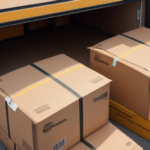What Happens to Returned Items on Amazon?
Online shopping has transformed the retail landscape, offering unparalleled convenience by delivering products directly to consumers' doorsteps. However, this convenience comes with its own set of challenges, particularly regarding the management of returned items. Amazon, as one of the largest e-commerce platforms globally, handles millions of returns each year. This article delves into the lifecycle of returned items on Amazon, the financial and environmental impacts, and offers insights into future trends in return management.
The Common Reasons for Amazon Returns
Understanding why items are returned is crucial for both consumers and sellers. Common reasons for returns on Amazon include:
- Wrong Size or Color: Apparel and accessories often see high return rates due to sizing issues or color discrepancies.
- Product Not as Described: When items do not match their online descriptions or images, customers are more likely to return them.
- Defective or Damaged: Products that arrive damaged or become defective shortly after use are frequently returned.
- Changed Mind or No Longer Needed: Sometimes, customers simply change their minds about a purchase.
- Late Delivery: Delays in delivery can prompt customers to cancel orders and seek alternatives.
- Better Deals Elsewhere: Discovering the same product at a lower price can lead to returns.
In 2022, Amazon reported a return rate of approximately 20%, highlighting the significance of efficient return handling for both customer satisfaction and operational costs.
Amazon's Returns Process
Initial Evaluation
When a return is initiated, Amazon evaluates the condition of the returned item to determine its next steps. This evaluation assesses whether the product is still sellable, requires refurbishment, or should be discarded.
Resale of Returned Items
Items deemed in good condition are restocked and made available for resale, often through Amazon Warehouse Deals, which offer products at discounted prices.
Liquidation and Third-Party Partnerships
For items that cannot be resold as new, Amazon collaborates with third-party liquidation companies. These companies purchase bulk returned items at reduced prices and resell them to other businesses or consumers.
Donation and Recycling
Amazon also donates returned items that are still in usable condition to charitable organizations. Additionally, electronic items may be sent to specialized recycling centers to minimize environmental impact.
The Financial Impact of Returns on Amazon
Returns significantly affect Amazon's financial performance. In 2022, returns cost the company an estimated $25 billion. Despite the high costs, Amazon's generous return policy helps maintain customer loyalty and repeat business, which are vital for long-term profitability.
Strategies to Mitigate Financial Losses
- Amazon Warehouse Deals: Selling returned items at discounted prices recovers some of the costs.
- Third-Party Sellers: Allowing third-party sellers to manage their own returns reduces Amazon's logistical burden.
- Data Analytics: Utilizing data to predict return trends helps Amazon optimize inventory and reduce excess returns.
The Environmental Impact of Returns
The return process contributes to Amazon's overall carbon footprint. Shipping items back and forth requires significant energy, and the disposal of unsellable items can lead to increased waste. In 2022, the estimated carbon emissions from returns operations were over 10 million metric tons.
Sustainable Practices
- Eco-Friendly Packaging: Using recyclable and biodegradable materials for packaging reduces environmental impact.
- Consolidated Shipments: Combining multiple returns into single shipments lowers transportation emissions.
- Donations and Recycling: Donating usable items and recycling materials help minimize waste.
The Future of Amazon Returns: Trends and Predictions
As e-commerce continues to grow, Amazon is likely to adopt innovative approaches to handle returns more efficiently and sustainably.
Technological Innovations
- Artificial Intelligence: AI can predict return likelihoods and help optimize inventory management.
- Smart Packaging: Intelligent packaging solutions can reduce the environmental impact of returns.
Customer Experience Enhancements
- Instant Refunds: Providing immediate refunds upon return initiation enhances customer satisfaction.
- Expanded Return Locations: Partnerships with retail stores like Kohl’s and Whole Foods facilitate easier returns for customers.
Tips for Minimizing Returns on Amazon
Both customers and sellers can take steps to reduce the number of returns, benefiting everyone involved.
For Customers:
- Read product descriptions thoroughly to ensure the item meets your needs.
- Check customer reviews and ratings to gauge product quality.
- Verify sizing charts before purchasing apparel and footwear.
- Choose sellers with high ratings and positive feedback.
For Sellers:
- Provide accurate and detailed product information.
- Use high-quality images to represent products accurately.
- Ensure prompt and reliable shipping to meet customer expectations.
- Implement quality control measures to reduce defective items.
Handling Unclaimed or Undeliverable Packages
Packages that are undeliverable due to incorrect addresses, unavailability of recipients, or other issues are returned to Amazon’s fulfillment centers. These items undergo the standard return evaluation process:
- If the item is in sellable condition, it is restocked and made available for purchase.
- If unsellable, it is sent to liquidation partners or donated to charities.
- Electronic items are often sent for recycling to manage e-waste responsibly.
Conclusion
Returns are an integral part of the e-commerce ecosystem, and Amazon continues to refine its processes to balance customer satisfaction with operational efficiency. By implementing sustainable practices and leveraging technology, Amazon aims to reduce the financial and environmental impacts of returns. As the industry evolves, the strategies employed by Amazon in handling returns may serve as a model for other retailers striving to enhance their return management systems.




















